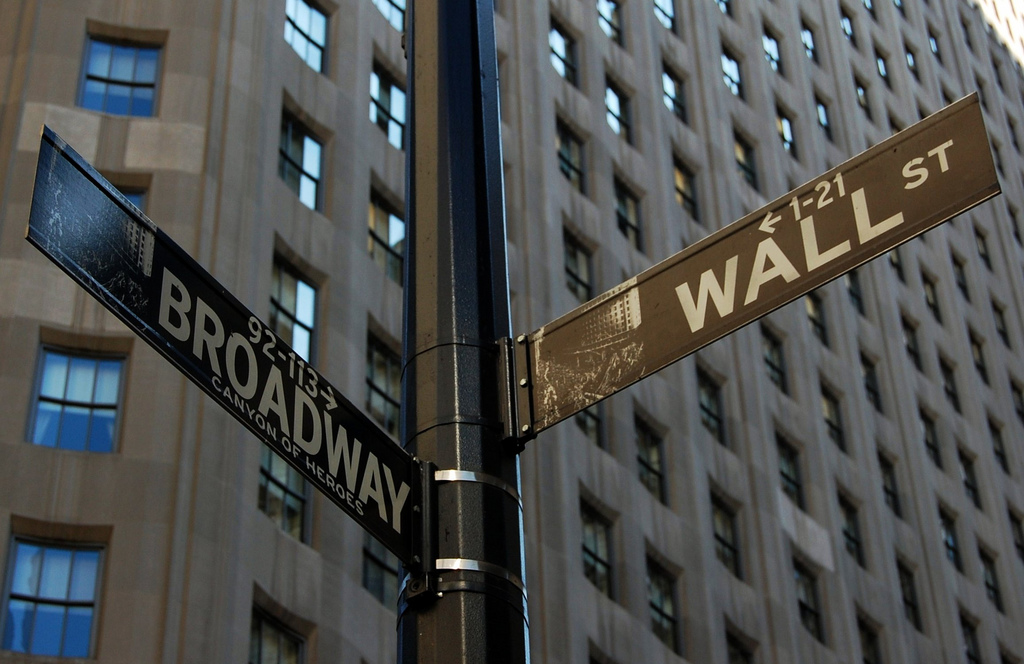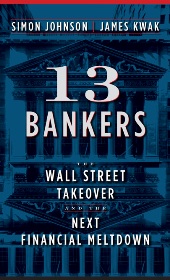
Despite the bailouts and stimulus packages, Simon Johnson sees trouble ahead. Johnson, a professor at MIT’s Sloan School of Management, argues in his and James Kwak’s 13 Bankers: The Wall Street Takeover and the Next Financial Meltdown, that big banks still rule the global economy and are setting us up for the next meltdown. In the excerpt below, Johnson, who spoke about his book at Zócalo, and Kwak recount the events of one crucial White House meeting and explain why governments need bankers and why the U.S. has spawned the world’s most advanced oligarchy.
 Friday, March 27, 2009, was a lovely day in Washington, D.C. – but not for the global economy. The U.S. stock market had fallen 40 percent in just seven months, while the U.S. economy had lost 4.1 million jobs.2 Total world output was shrinking for the first time since World War II.
Friday, March 27, 2009, was a lovely day in Washington, D.C. – but not for the global economy. The U.S. stock market had fallen 40 percent in just seven months, while the U.S. economy had lost 4.1 million jobs.2 Total world output was shrinking for the first time since World War II.
Despite three government bailouts, Citigroup stock was trading below $3 per share, about 95 percent down from its peak; stock in Bank of America, which had received two bailouts, had lost 85 percent of its value. The public was furious at the recent news that American International Group, which had been rescued by commitments of up to $180 billion in taxpayer money, was paying $165 million in bonuses to executives and traders at the division that had nearly caused the company to collapse the previous September. The Obama administration’s proposals to stop the bleeding, initially panned in February, were still receiving a lukewarm response in the press and the markets. Prominent economists were calling for certain major banks to be taken over by the government and restructured. Wall Street’s way of life was under threat.
That Friday in March, thirteen bankers – the CEOs of thirteen of the country’s largest financial institutions – gathered at the White House to meet with President Barack Obama.* “Help me help you,” the president urged the group. Meeting with reporters later, they toed the party line. White House press secretary Robert Gibbs summarized the president’s message: “Everybody has to pitch in. We’re all in this together.” “I’m of the feeling that we’re all in this together,” echoed Vikram Pandit, CEO of Citigroup. Wells Fargo CEO John Stumpf repeated the mantra: “The basic message is, we’re all in this together.” What did that mean, “we’re all in this together”? It was clear that the thirteen bankers needed the government. Only massive government intervention, in the form of direct investments of taxpayer money, government guarantees for multiple markets, practically unlimited emergency lending by the Federal Reserve, and historically low interest rates, had prevented their banks from following Bear Stearns, Lehman Brothers, Merrill Lynch, Washington Mutual, and Wachovia into bankruptcy or acquisition in extremis. But why did the government need the bankers?
Any modern economy needs a financial system, not only to process payments, but also to transform savings in one part of the economy into productive investment in another part of the economy. However, the Obama administration had decided, like the George W. Bush and Bill Clinton administrations before it, that it needed this financial system – a system dominated by the thirteen bankers who came to the White House in March. Their banks used huge balance sheets to place bets in brand-new financial markets, stirring together complex derivatives with exotic mortgages in a toxic brew that ultimately poisoned the global economy. In the process, they grew so large that their potential failure threatened the stability of the entire system, giving them a unique degree of leverage over the government. Despite the central role of these banks in causing the financial crisis and the recession, Barack Obama and his advisers decided that these were the banks the country’s economic prosperity depended on. And so they dug in to defend Wall Street against the popular anger that was sweeping the country – the “pitchforks” that Obama referred to in the March 27 meeting.
To his credit, Obama was trying to take advantage of the Wall Street crisis to wring concessions from the bankers – notably, he wanted them to scale back the bonuses that enraged the public and to support his administration’s plan to overhaul regulation of the financial system. But as the spring and summer wore on, it became increasingly clear that he had failed to win their cooperation. As the megabanks, led by JPMorgan Chase and Goldman Sachs, reported record or near-record profits (and matching bonus pools), the industry rolled out its heavy artillery to fight the relatively moderate reforms proposed by the administration, taking particular aim at the measures intended to protect unwary consumers from being blown up by expensive and risky mortgages, credit cards, and bank accounts. In September, when Obama gave a major speech at Federal Hall in New York asking Wall Street to support significant reforms, not a single CEO of a major bank bothered to show up. If Wall Street was going to change, Obama would have to use (political) force.
Why did this happen? Why did even the near-collapse of the financial system, and its desperate rescue by two reluctant administrations, fail to give the government any real leverage over the major banks?
By March 2009, the Wall Street banks were not just any interest group. Over the past thirty years, they had become one of the wealthiest industries in the history of the American economy, and one of the most powerful political forces in Washington. Financial sector money poured into the campaign war chests of congressional representatives. Investment bankers and their allies assumed top positions in the White House and the Treasury Department. Most important, as banking became more complicated, more prestigious, and more lucrative, the ideology of Wall Street – that unfettered innovation and unregulated financial markets were good for America and the world – became the consensus position in Washington on both sides of the political aisle. Campaign contributions and the revolving door between the private sector and government service gave Wall Street banks influence in Washington, but their ultimate victory lay in shifting the conventional wisdom in their favor, to the point where their lobbyists’ talking points seemed self-evident to congressmen and administration officials. Of course, when cracks appeared in the consensus, such as in the aftermath of the financial crisis, the banks could still roll out their conventional weaponry – campaign money and lobbyists; but because of their ideological power, many of their battles were won in advance.
The political influence of Wall Street helped create the laissez-faire environment in which the big banks became bigger and riskier, until by 2008 the threat of their failure could hold the rest of the economy hostage. That political influence also meant that when the government did rescue the financial system, it did so on terms that were favorable to the banks. What “we’re all in this together” really meant was that the major banks were already entrenched at the heart of the political system, and the government had decided it needed the banks at least as much as the banks needed the government. So long as the political establishment remained captive to the idea that America needs big, sophisticated, risk-seeking, highly profitable banks, they had the upper hand in any negotiation. Politicians may come and go, but Goldman Sachs remains.
The Wall Street banks are the new American oligarchy – a group that gains political power because of its economic power, and then uses that political power for its own benefit. Runaway profits and bonuses in the financial sector were transmuted into political power through campaign contributions and the attraction of the revolving door. But those profits and bonuses also bolstered the credibility and influence of Wall Street; in an era of free market capitalism triumphant, an industry that was making so much money had to be good, and people who were making so much money had to know what they were talking about. Money and ideology were mutually reinforcing.
This is not the first time that a powerful economic elite has risen to political prominence. In the late nineteenth century, the giant industrial trusts – many of them financed by banker and industrialist J. P. Morgan – dominated the U.S. economy with the support of their allies in Washington, until President Theodore Roosevelt first used the antitrust laws to break them up. Even earlier, at the dawn of the republic, Thomas Jefferson warned against the political threat posed by the Bank of the United States.
In the United States, we like to think that oligarchies are a problem that other countries have. The term came into prominence with the consolidation of wealth and power by a handful of Russian businessmen in the mid-1990s; it applies equally well to other emerging market countries where well-connected business leaders trade cash and political support for favors from the government. But the fact that our American oligarchy operates not by bribery or blackmail, but by the soft power of access and ideology, makes it no less powerful. We may have the most advanced political system in the world, but we also have its most advanced oligarchy.
Excerpted from 13 Bankers by Simon Johnson and James Kwak Copyright © 2010 by Simon Johnson. Excerpted by permission of Pantheon, a division of Random House, Inc. All rights reserved. No part of this excerpt may be reproduced or reprinted without permission in writing from the publisher.
*Photo courtesy jpellgen.




Send A Letter To the Editors